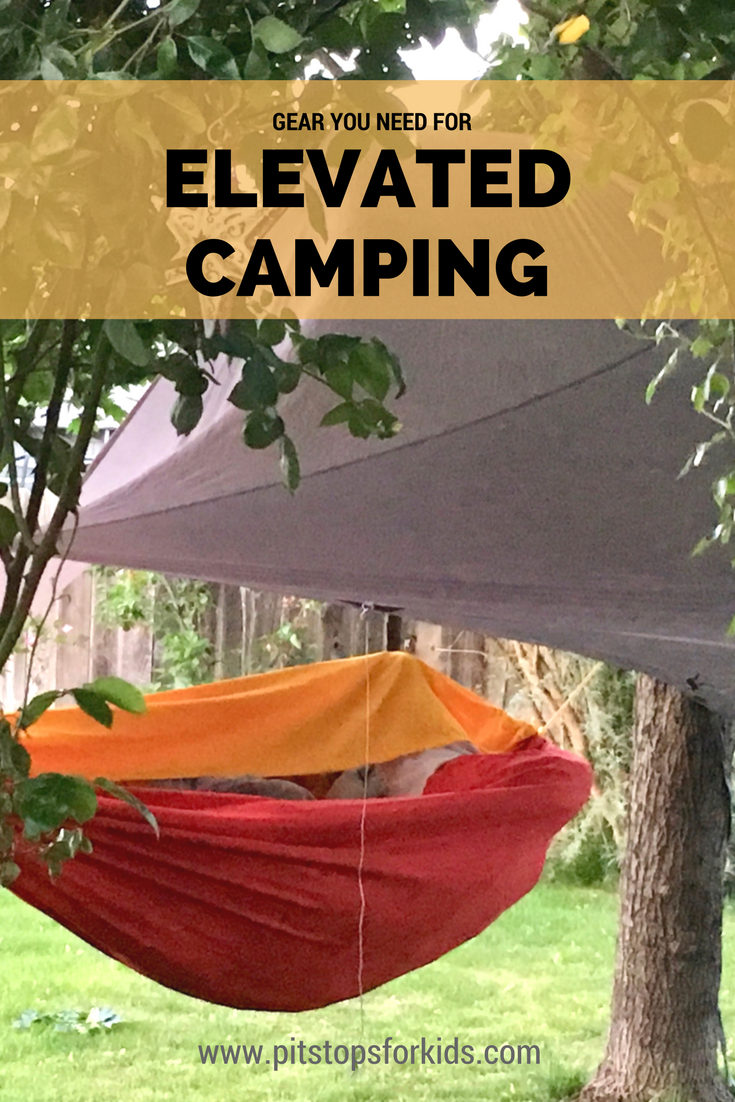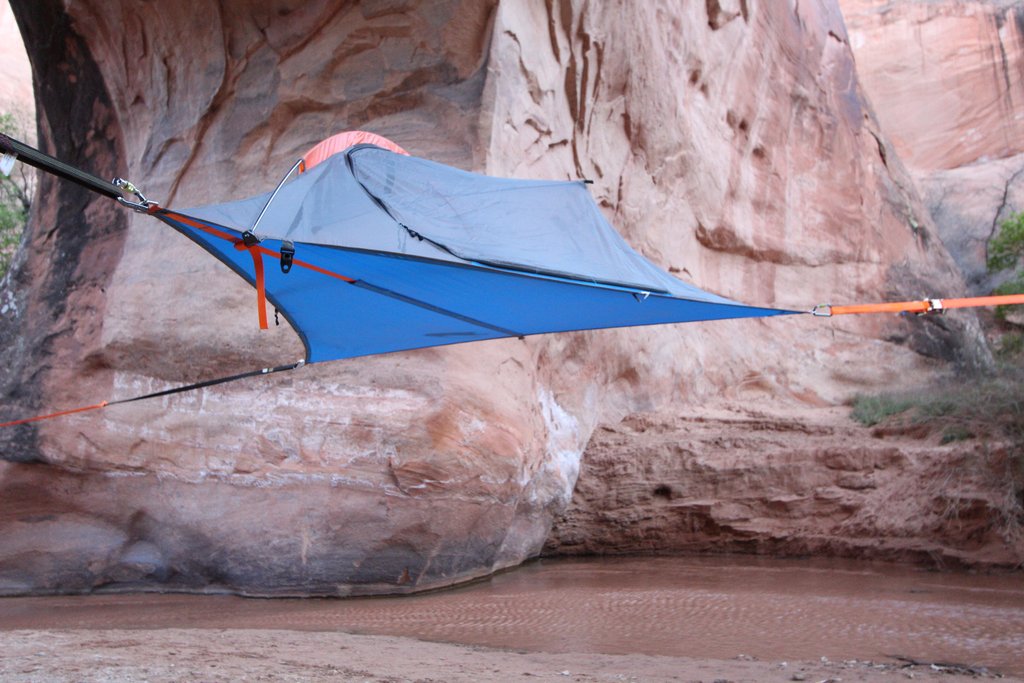Have you ever wanted to camp off the ground? Elevated camping is becoming more and more popular, because camping in tents and hammocks designed to be strung in trees allows families to camp on un-even terrain, away from pesky insects, and out of the elements. It’s also just super fun and cool. If you want to try elevated camping, here’s what you’ll need!

Kammok Wallaby paired with the Dragonfly net and Kuhli tarp
Table of Contents
Gear for elevated camping:
Start with your hammock:
The first step to gear up for any elevated camping situation is to select your hammock. You don’t have to get fancy, but you will want to consider your various hammock options. Below, we’ve listed some of our favorites, and why we love them.
Grand Trunk: You can’t go wrong with a Grand Trunk hammock, in our opinion. We’ve tried many, from the lightweight single parachute nylon model for just $59 to the Skeeter Beeter Pro, which has integrated mosquito netting built in. You can get a double or single hammock in all kinds of fun colors and patterns at Grand Trunk.
Kammok: We love the Kammok Wallaby, which is just $65 and comes in multiple colors. Pair the Wallaby with Kammok’s Python Straps for $30 more, which make any hammock easier to suspend from just about anywhere. Either Kammok or Grand Trunk options would make for a great base hammock.
Sea to Summit: Sea to Summit makes an ultralight hammock that’s an absolute must if you’re purpose for elevated camping is to go light. It’s very thin, so you’d definitely need to pair it with a hammock pad (see below) to protect yourself from cold temperatures at night.
Kammok Wallaby
Add your pad layer:
Klymit Hammock V pad: If you’re serious about sleeping above the ground, you’ll want the protection of a sleeping pad. Not only does the right pad help your hammock keep its shape (so you don’t roll up like a burrito) but it keeps you warm…without a pad, you’re exposed to the cold night air directly. Klymit makes a specialized hammock pad that’s shaped to fit. The Hammock V pad comes in an insulated version or non-insulated, and while it will set you back $169, we recommend the insulated if you’ll be doing a lot of camping.
If you use a regular sleeping pad instead, pick one that’s small and narrow to fit the hammock, and consider covering it with a specialized pad sheet, to reduce slippage. Klymit makes one of these too…the Quilted V Sheet will work, and it’s oh-so cozy!
Add your rain and bug protection:
Kammok Kuhli tarp or Grand Trunk Air Bivy: Both these items give solid protection from wind and rain, serving as a shelter/rainfly for your hammock. Of course, they don’t cover 100% of the space, so you’re still going to get wet if the rain comes in sideways. The Kuhli tarp and the Air Bivy are both extremely versatile and lightweight, making them a great addition to your camping gear whether you sleep elevated or not. We’ve used both for BBQs, car camping, and the like.
Sea to Summit Bug Net: For 13 more ounces, you can be protected from flying insects while sleeping in your hammock…worth it in my book! The Sea to Summit bug net works with all Sea to Summit hammocks. We haven’t tried it with other hammocks.
Grand Trunk Mozzy Net: The Mozzy Net is a good option because it’s versatile…it stands alone, so can be used with any hammock or even around a picnic table or kitchen area. The downside: it’s a bit clunky to set up; the multiple guy lines that make it adjustable to any situation also make it complicated to get the right shape until you’ve had practice.
Add-on: Portable microscope
You’re up in the trees, so what can you see? When going camping with kids, it is always a good idea to pack some devices that can provide entertainment even though their primary purpose is educational. Such a device is a handheld microscope as it is an easy-to-use product that lets children explore the world around them, and even more, the world they can’t see with the naked eye. Usually, a handheld microscope connects to one’s smartphone, tablet, or laptop in order to provide magnified images of leaves, fruit, and a myriad of insects that one might discover at a campsite. This way, your trip with the kids can be both instructive and fun, as you’ll spend some time gathering items and bugs that you can look at in-depth.
Want to go big? Try a tent-hammock combo!
Kammok Sunda: If you want your hammock to actually be a tent, and vice versa, the Kammok Sunda is a two-person tent and hammock hybrid. It’s very pretty, but even better, it can convert to a stand-alone tent or a stand-alone hammock, depending your needs. This is a great feature, as there will be times you want to set up your tent-hammock in the air, but cannot find the suitable trees to do so. The Sunda is on pre-order right now, for $349.
Tentsile Flite
Tentsile: We’re currently testing a Tentsile Connect, and have packed it a few miles into a lake in Northern California’s Trinity Alps. It’s heavy enough to relegate it to car camping and short backpacking trips, but oh-so-cool! It sets up with a ratcheting system for suspension that has a learning curve but is easy once you’ve tried it a few times. In our experience, a couple teenage boys armed only with the YouTube tutorial video were able to set it up in about 10 minutes on the first try. There are many sizes and styles of Tentsiles to choose from (some, but not all, get quite expensive). Tentsile tents come with rainflies, which can be pegged on the ground, though the tents themselves are not meant to be on the ground. The two-person Tentsile we like best is $350.

Tentsile Connect, set up in Trinity Alps CA
Note: the downside of elevated tents is their weight. Even hammocks can get heavy, once you add the rope you need, your tarp or cover, and a mosquito net. If you want to travel light, be sure to add up the weight of your elevated camping system before committing!
Pin it for later!








